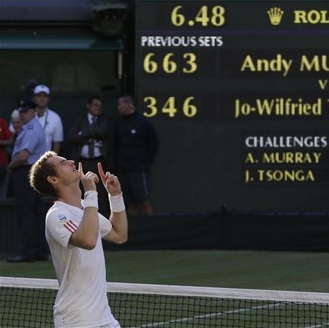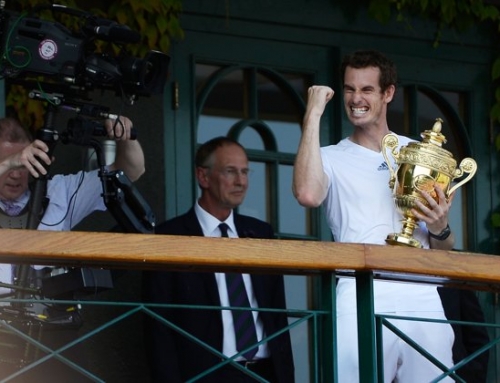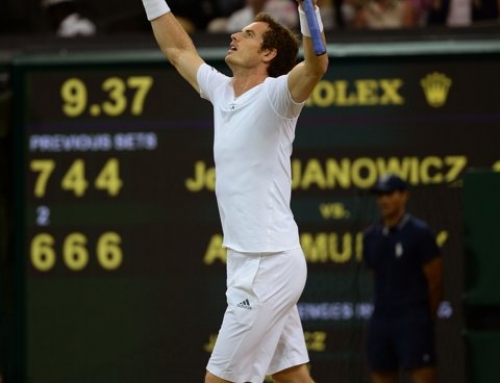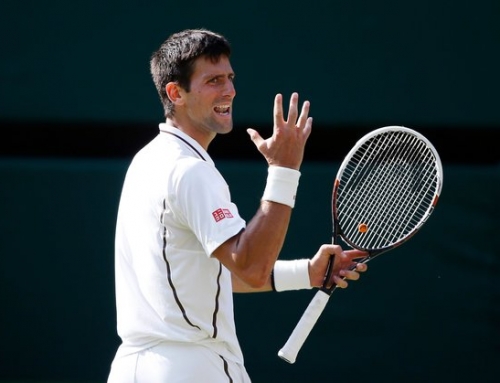 Going into the semifinals, my thoughts were that Djokovic would be like a human backboard and Federer would frustrate himself into a loss. I also thought Murray would tough out a win over Tsonga, a player that he’d only lost to in their initial meeting back in Tsonga’s run to the Australian Open final in 2008.
Going into the semifinals, my thoughts were that Djokovic would be like a human backboard and Federer would frustrate himself into a loss. I also thought Murray would tough out a win over Tsonga, a player that he’d only lost to in their initial meeting back in Tsonga’s run to the Australian Open final in 2008.
Let’s take the first match first. The first match was played at lightning speed, at least for the first two sets. Federer made an unusual decision. Federer typically serves around 125 mph on first serves. Maybe a shade higher. Maybe a shade lower. He’s never been one to clock his serves at 130 mph or higher, preferring the comfort, rhythm, and accuracy he gets at that speed. For some reason, he chose to serve at about 115 mph. Even so, Fed has one of those serves that seems really hard to read for about a set before the other player figures it out, so Fed held serve pretty comfortably in the first set.
Fed is trying to play pretty aggressive off the ground, which is what he normally does. The key for Roger in this match was his serve. Except for the second set, it kept Novak guessing. The second set was better for Novak as he was able to get into longer rallies and begin to win more of them. Fed plays a sloppy game early in the second set and Djokovic goes on to win with each holding serve.
Toward the start of the third set, as Djokovic is getting more returns in play, Federer is still doing a pretty good job of holding serve, but doing so with extended groundstroke rallies. It just feels like all Fed has to do is to hit well on Novak’s serve and he would be in Djokovic’s service games. In the third set, Fed is feeling so good about his backhand that he’s willing to take prolonged rallies from his backhand to Djokovic’s backhand.
Late in the third set, Djokovic feels like Roger is bullying him. In all the matches he’s played with Nadal, despite Nadal’s ability to move him around, Novak has always seemed into the match, fairly confident. He looks surprisingly intimidated and not able to fully relax to hit his shots.
Roger plays an aggressive game in the last game of the third set to break and take the set. This bad stretch continues in the fourth set when Djokovic makes a bunch of errors, and Roger’s aggression allows him to take an early break. Djokovic struggles to get into Federer’s games and so Federer pretty much has this, and even had chances to get a second break.
Murray started his match serving on fire. Tsonga had a tough time reading his serve, especially out wide. But Tsonga, of all the semifinalists, has chosen to come into net a lot. More than Federer and probably more than Fish. Tsonga’s touch at the net, like many Frenchmen, is impeccable. He hits drop volley after drop volley and Murray can barely touch them. However, Murray’s able to pressure Tsonga into errors on his forehand, and with his serving exhibition, Tsonga struggles to keep even.
Bam, Murray has two sets, and the announcers say that Tsonga isn’t likely to go away. If he gets one break, he might get back in it. All of a sudden, Murray, who had not been missing at all on serve, missed a bunch, and spun in really short second serves. Tsonga also compensated by shading wide to get a poke at the wide serves, and from then on, it’s a bit of a tussle. Murray’s confidence seems to have dropped while Tsonga’s confidence has risen and he’s starting to punish the ball.
Tsonga takes the third set. Murray said, after the third set, his primary thought was to hold serve early in the fourth and not get into a hole like he did in the third set. Murray appears to turn the momentum to his favor when he breaks in the middle of the fourth set, but Tsonga comes back and breaks him again. What’s key for Murray is what he does in games like 4-all and 5-all where he was down 15-40 and 15-3o respectively. He was partly helped by Tsonga playing a bit too aggressive on return, but he managed to hold serve, and that was key. Champions fight off break points.
Finally, Murray pounces. With Tsonga missing first serves, Murray is able to get him 0-30 then down 15-40 when Tsonga hits a volley deep. Murray tags a return that is initially called out and then successfully challenged in to get the break.
This match felt like it belonged to Murray in straights, and yet, it wouldn’t do for the long-suffering British for Murray to have an easy match. Up until the third set, this was ass dominant as Murray had played since the first round.
So while Federer felt like in control as an underdog, Murray’s match felt like he had to scrape to win the last two sets, but he was up to it.
Murray’s road has been the harder one so far, and he’s managed to deal with everyone he’s faced so far. I think Federer would gladly take the draw he had, except for Djokovic, over the draw Murray had.
Federer once said, during the leadup to the Australian Open finals back in 2010, that his strategy was “aggressive”. Not “being aggressive”, just “aggressive”. Back then, when Murray was beating Federer, Fed had been slumping and shanking a lot of shots. This allowed Murray to play patient ball against Federer. He tried to do exactly that back in 2010, hitting a series of backhands to Fed trying to break it down. If anything, Fed’s backhand may be strong now than it was then, and it was pretty good then (but went in decline).
Fed desperately wants to win Wimbledon again, because it will do a ton for him. Not only will he tie Sampra’ss record at Wimbledon, more importantly, he becomes number 1. With all the top pros not playing any events for a few weeks, He’ll also beat Sampras’s record of weeks at number 1, the one record no one thought Federer would win.
Fed will go in pretty confident because he beat Murray back in Dubai in the finals when Federer took an aggressive approach (as he always does). The question is how Murray should play Federer. He’ll probably ditch efforts to outsteady him.
You did see some interesting tactics where Murray would slice crosscourt and short and draw Tsonga up to the net. This is old-school Murray, the one that concocts weird shots to throw his opponents off. The key, for both players, will be the serve. Who serves and holds best.
It will also be interesting to see what advice Lendl will offer. He apparently told Murray not to practice his serve so much during the tournament, that he would hit plenty of serves and he needed to preserve his shoulder. He attributes this to feeling fresher than has in the past.
Murray said, in the past, without a proven champ like Lendl, his team tended to dissect and overanalyze every decision. If anything, Lendl, who is pretty analytical himself, will likely find ways not to overthink things, or at the very least, through years of experience, he’ll have known what decision worked and why.
Murray’s taken the more punishing route here (not that Federer’s has been easy either), but that will probably help him get out of messes in the final.
Anyway, the British media is likely to be tense about how Andy will do. He’s already gone one step further than Tim Henman ever did, but that’s not enough. For a Brit to win Wimbledon is like a Frenchman winning the French. It’s so difficult to do this, and yet Andy has felt the pressure year after year, and so those years of experience are likely to help. But same for Federer who is trying for more history before he hangs it up.
It will certainly be an intriguing Wimbledon final.







![[Wimbledon, QF] Murray scraps out 5-set win over Verdasco to reach semifinals](https://www.essentialtennis.com/wp-content/uploads/2013/07/20130703murray-500x383.jpg)